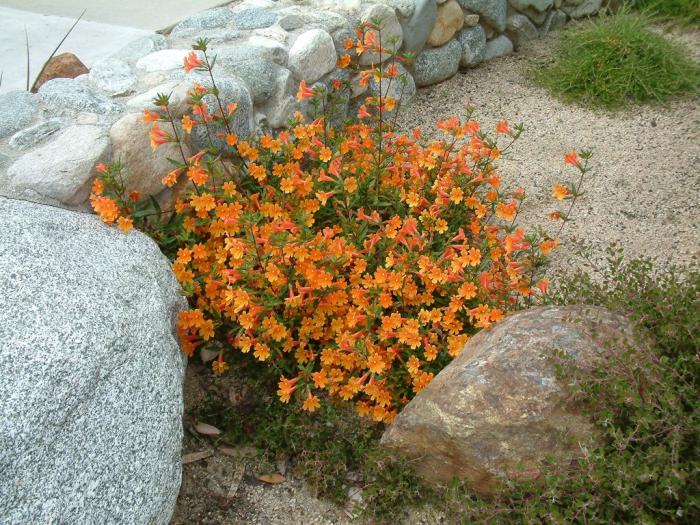
Mimulus 'Pumpkin'
Pumpkin Monkey Flower

Description
Mimulus 'Pumpkin' is one of the best performing and 'garden tolerant' of the dry Mimulus species/hybrids. Although it still requires well drained soil and drier conditions in most environments, it stays evergreen and can bloom through the year with supplemental summer water when other varieties will die. It reaches 18"-24"and wide; it blooms profusely with two toned, pumpkin orange flowers. It is truly stunning and effective in the garden, especially in mass.
Maintenance Tips
Mimulus 'Pumpkin' is a California native hybrid perennial. It’s grown for its red-orange, tube-like blossoms that are attractive to pollinators, such as bees and hummingbirds. It has thin glossy leaves and can grow up to 2' tall and wide. Flowers will appear on flower stalks for most of the year but will show up in high numbers in the spring and until summer. Throughout the flowering season, just remove flower stalks from the base, as needed, when each stalk has appeared to stop sending out new flowers. In the late summer, you can cut back the foliage by one-third of the current size and remove any additional branches that have died back.
Plant Type
Perennial
Height Range
1-3'
Flower Color
Orange
Flower Season
Spring, Summer
Leaf Color
Green, Dark Green
Bark Color
n/a
Fruit Color
n/a
Fruit Season
n/a
Sun
Full, Half
Water
Medium
Growth Rate
Fast
Soil Type
Sandy, Loam, Rocky
Soil Condition
Average, Well-drained, Dry
Soil pH
Neutral
Adverse Factors
Attracts Bees
Design Styles
English Cottage, Meadow, Mediterranean, Ranch, Wild Garden
Accenting Features
Showy Flowers
Seasonal Interest
Spring, Summer
Location Uses
Entry, Perennial Border, Parking Strip, Patio, Raised Planter, Walkways, With Rocks
Special Uses
Container, Mass Planting, Fire Resistant, Small Spaces
Attracts Wildlife
Hummingbirds
Water Saving Tip:
Weather changes - so should your watering schedule. Be sure to make seasonal watering adjustments at a minimum.